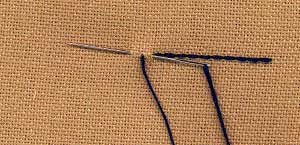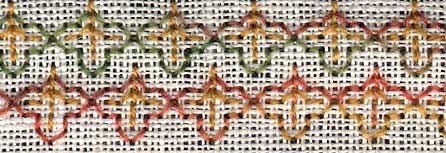Back Stitch


![]() Back
stitch is also known as point de sable.
Back
stitch is also known as point de sable.

Back stitch is an old and very adaptable stitch which can be used as a delicate outline or as a foundation in composite stitches, such as Pekinese stitch and herringbone ladder filling stitch.
This stitch follows intricate curves well if the stitches are worked in small and in an even manner in order to follow the flow of the curve. The front of the work is similar in appearance to Holbein stitch but, where Holbein stitch is quite flat, back stitch is slightly raised.
If you want to work blackwork patterns using variegated and hand dyed threads use back stitch. Many blackwork patterns can be very effective worked this way.
To start this stitch bring the thread up from the back of the fabric on the line that you want to create. Make a small backward stitch through the fabric. Bring the needle through the fabric a little in front of the first stitch and still on the line. Pull the thread through the fabric. Make the second stitch backward, bringing the needle out a little in front of the second stitch and still on the line. Repeat this movement and continue sewing in such a manner along the line.

